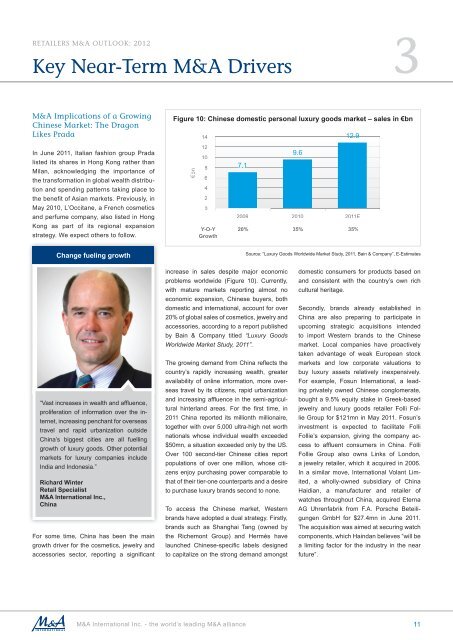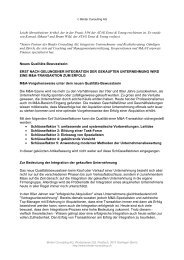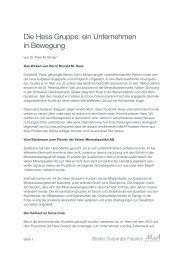Cosmetics, Jewelry & Accessories Retailers M&A Outlook: If You ...
Cosmetics, Jewelry & Accessories Retailers M&A Outlook: If You ...
Cosmetics, Jewelry & Accessories Retailers M&A Outlook: If You ...
You also want an ePaper? Increase the reach of your titles
YUMPU automatically turns print PDFs into web optimized ePapers that Google loves.
RetaileRs M&a OutlOOk: 2012<br />
key Near-term M&a Drivers<br />
M&a implications of a Growing<br />
Chinese Market: the Dragon<br />
likes Prada<br />
In June 2011, Italian fashion group Prada<br />
listed its shares in Hong Kong rather than<br />
Milan, acknowledging the importance of<br />
the transformation in global wealth distribution<br />
and spending patterns taking place to<br />
the benefit of Asian markets. Previously, in<br />
May 2010, L’Occitane, a French cosmetics<br />
and perfume company, also listed in Hong<br />
Kong as part of its regional expansion<br />
strategy. We expect others to follow.<br />
Change fueling growth<br />
“Vast increases in wealth and affl uence,<br />
proliferation of information over the internet,<br />
increasing penchant for overseas<br />
travel and rapid urbanization outside<br />
China’s biggest cities are all fuelling<br />
growth of luxury goods. Other potential<br />
markets for luxury companies include<br />
India and Indonesia.”<br />
Richard Winter<br />
Retail Specialist<br />
M&A International Inc.,<br />
China<br />
For some time, China has been the main<br />
growth driver for the cosmetics, jewelry and<br />
accessories sector, reporting a signifi cant<br />
increase in sales despite major economic<br />
problems worldwide (Figure 10). Currently,<br />
with mature markets reporting almost no<br />
economic expansion, Chinese buyers, both<br />
domestic and international, account for over<br />
20% of global sales of cosmetics, jewelry and<br />
accessories, according to a report published<br />
by Bain & Company titled “Luxury Goods<br />
Worldwide Market Study, 2011”.<br />
The growing demand from China refl ects the<br />
country’s rapidly increasing wealth, greater<br />
availability of online information, more overseas<br />
travel by its citizens, rapid urbanization<br />
and increasing affl uence in the semi-agricultural<br />
hinterland areas. For the fi rst time, in<br />
2011 China reported its millionth millionaire,<br />
together with over 5,000 ultra-high net worth<br />
nationals whose individual wealth exceeded<br />
$50mn, a situation exceeded only by the US.<br />
Over 100 second-tier Chinese cities report<br />
populations of over one million, whose citizens<br />
enjoy purchasing power comparable to<br />
that of their tier-one counterparts and a desire<br />
to purchase luxury brands second to none.<br />
To access the Chinese market, Western<br />
brands have adopted a dual strategy. Firstly,<br />
brands such as Shanghai Tang (owned by<br />
the Richemont Group) and Hermès have<br />
launched Chinese-specifi c labels designed<br />
to capitalize on the strong demand amongst<br />
M&A International Inc. - the world’s leading M&A alliance<br />
bn<br />
14<br />
12<br />
10<br />
8<br />
6<br />
4<br />
2<br />
0<br />
Y-O- Y Y<br />
Growth<br />
7.1<br />
9.6<br />
12.9<br />
2009 2010 2011E<br />
20%<br />
35% 35%<br />
3<br />
Figure 10: Chinese domestic personal luxury goods market – sales in €bn<br />
Source: “Luxury Goods Worldwide Market Study, 2011, Bain & Company”, E-Estimates<br />
domestic consumers for products based on<br />
and consistent with the country’s own rich<br />
cultural heritage.<br />
Secondly, brands already established in<br />
China are also preparing to participate in<br />
upcoming strategic acquisitions intended<br />
to import Western brands to the Chinese<br />
market. Local companies have proactively<br />
taken advantage of weak European stock<br />
markets and low corporate valuations to<br />
buy luxury assets relatively inexpensively.<br />
For example, Fosun International, a leading<br />
privately owned Chinese conglomerate,<br />
bought a 9.5% equity stake in Greek-based<br />
jewelry and luxury goods retailer Folli Follie<br />
Group for $121mn in May 2011. Fosun’s<br />
investment is expected to facilitate Folli<br />
Follie’s expansion, giving the company access<br />
to affl uent consumers in China. Folli<br />
Follie Group also owns Links of London,<br />
a jewelry retailer, which it acquired in 2006.<br />
In a similar move, International Volant Limited,<br />
a wholly-owned subsidiary of China<br />
Haidian, a manufacturer and retailer of<br />
watches throughout China, acquired Eterna<br />
AG Uhrenfabrik from F.A. Porsche Beteiligungen<br />
GmbH for $27.4mn in June 2011.<br />
The acquisition was aimed at securing watch<br />
components, which Haindan believes “will be<br />
a limiting factor for the industry in the near<br />
future”.<br />
11





